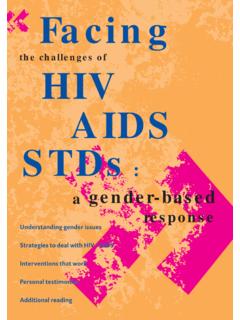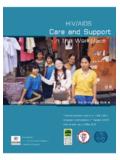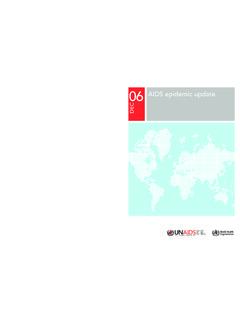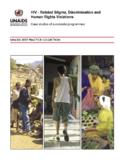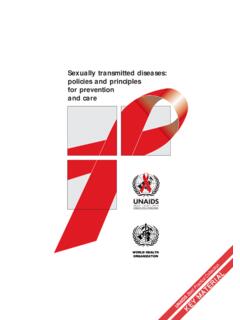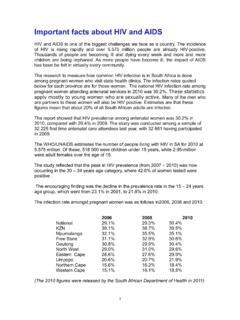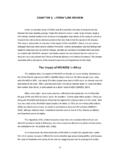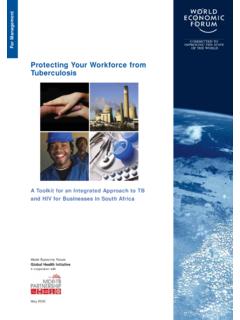Transcription of The Media and HIV/AIDS
1 Making a differenceThe Media and HIV/AIDS : GLOBAL Media GLOBAL Media INITIATIVEAIDSUNAIDS concerning the legal status of any country, territory, city or area or of its authorities, or concerning the delimitation of its frontiers or boundaries. The mention of specifi c companies or of certain manufacturers products does not imply that they are endorsed or recommended by UNAIDS in preference to others of a similar nature that are not mentioned. Errors and omissions excepted, the names of proprietary products are distinguished by initial capital does not warrant that the information contained in this publication is complete and correct and shall not be liable for any damages incurred as a result of its 20 avenue Appia 1211 Geneva 27 SwitzerlandTelephone: (+41) 22 791 36 66 Fax: (+41) 22 791 41 87E-mail: Internet: (English original, January 2004) Joint United Nations Programme on HIV/AIDS (UNAIDS) rights reserved.
2 Publications produced by UNAIDS can be obtained from the UNAIDS Information Centre. Requests for permission to reproduce or translate UNAIDS publications whether for sale or for noncom-mercial distribution should also be addressed to the Information Centre at the address below, or by fax, at +41 22 791 4187, or e-mail: The designations employed and the presentation of the material in this publication do not imply the expression of any opinion whatsoever on the part of WHO Library Cataloguing-in-Publication DataThe Media and HIV/AIDS : making the difference.
3 Infections prevention and control immunodefi ciency syndrome prevention and control Media utilization utilization dissemination health ISBN 92 9173 350 4 (NLM classifi cation: WC )Cover photo : MTV Young people from around the world interacting with celebrities and aids experts during the launch of the MTV Staying Alive campaign at the XIV International aids ConferenceThe Media and HIV/AIDS When you are working to combat a disastrous and growing emergency, you should use every tool at your disposal.
4 HIV/AIDS is the worst epidemic humanity has ever faced. It has spread further, faster and with more catastrophic long-term effects than any other disease. Its impact has become a devastating obstacle to development. Broadcast Media have tremendous reach and infl uence, particularly with young people, who represent the future and who are the key to any successful fi ght against HIV/AIDS . We must seek to engage these powerful organizations as full partners in the fi ght to halt HIV/AIDS through awareness, prevention, and education. Kofi Annan, United Nations Secretary-General5 The Media and HIV/AIDSUNAIDSThe global HIV/AIDS epidemicToday, 8,000 people will lose their lives to HIV/AIDS and another 14,000 10 people every single minute will become newly realities of today s global epidemic are graver than even the worst-case predictions of 10 years ago.
5 aids killed more than 3 million people in 2003 and an estimated 5 million more became infected bringing to some 40 million the number currently living with the virus. More than 20 million have already died since the first clinical evidence of the disease was reported in 1981. Sub-Saharan Africa remains the worst-affected region of the world, with one in five adults across southern Africa now HIV-infected. In countries such as Botswana and Swaziland, adult prevalence is approaching 40%. In many areas, aids is erasing decades of progress made in human development as young, productive people die, households fall into poverty, and the costs of the epidemic mount.
6 Average life expectancy in the region has declined from 62 years to 47, and continues to other parts of the world, the epidemic also shows no sign of abating. Eastern Europe and Central Asia are experiencing exponential expansions in levels of HIV infection, especially among the young. More than 1 million people in Asia and the Pacific became HIV-positive last year, while, in Latin America and the Caribbean, the epidemic is well entrenched; HIV/AIDS is a leading cause of death in a number of countries in the Caribbean Basin. UNAIDS / on bus stops in New York for the United Nations General Assembly Special Session on HIV/AIDSThe Media and HIV/AIDS 6 UNAIDS7 The Media and HIV/AIDSUNAIDSN orth America 790 000 millionLatin millionEastern Europe & Central Asia millionEast Asia & Pa cifi c700 000 millionCaribbean350 000 590 000 Australia & New Zealand12 000 18 000 Western Europe 520 000 680 000 South & South-East millionSub-Saharan Africa millionNorth Africa& Middle East470 000 730 000 TOTAL.
7 34 - 46 MILLIONADULTS AND CHILDREN ESTIMATED TO BE LIVING WITH HIV/AIDS , END 2003 Even in resource-rich nations such as the United States, where overall infection rates are relatively low, there has been no decrease in the number of new infections in over a decade and, among certain populations, HIV prevalence is increasing. A trend towards growing infection rates is also evident in the Middle East and North Africa, challenging the notion that any region has sidestepped the epidemic. UNAIDS and WHO estimate that, without dramatic increases in HIV-prevention efforts, some 45 million new infections will occur worldwide by 2010.
8 Source: UNAIDS/WHOThe Media and HIV/AIDS 6 UNAIDS7 The Media and HIV/AIDSUNAIDSOver the past three years, and in particular since the adoption by all members of the United Nations of a Declaration of Commitment on HIV/AIDS in 2001, a new momentum has resulted in greatly increased resources and renewed political commitment to fight the epidemic. However, efforts still fall far short of what is needed and much remains to be done to reach the United Nations Millennium Development Goal of halting and beginning to reverse the spread of HIV by this target and substantially reducing the global impact of this devastating epidemic requires collaboration from all sectors of society: educational institutions, government, religious organizations, and the mass Media .
9 In a landmark gathering in June 2001, Heads of State and Representatives of Governments met at the United Nations General Assembly Special Session on HIV/AIDS and fashioned a set of global commitments for tackling the epidemic. They affirmed, for example, that : Beyond the key role played by communities, strong partnerships among governments, the United Nations system,.. people living with aids and vulnerable groups,.. the Media , parliamentarians, foundations, community organisations and traditional leaders are important (para. 32). From the Declaration of Commitment on HIV/AIDS , adopted at the United Nations General Assembly Special Session on HIV/AIDS , 27 June 2001, New from KNOW HIV/AIDS campaignViacomThe Media and HIV/AIDS 8 UNAIDS9 The Media and HIV/AIDSUNAIDSThe Media have a pivotal role to play in the fight against aids .
10 It is often said that education is the vaccine against HIV. Many Media organizations are rising to the challenge by promoting awareness of HIV/AIDS and educating listeners and viewers about the facts of the epidemic and how to stop it. According to national surveys conducted in the United States, 72% of Americans identify television, radio and newspapers as their primary source of information about HIV/AIDS , more than doctors, friends and family. Similar statistics have also been reported in the United Kingdom and elsewhere in the a survey carried out in India more than 70% of respondents said they had received their information about HIV/AIDS from television.
